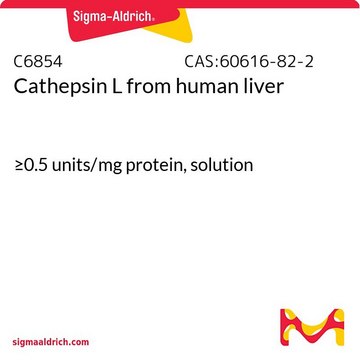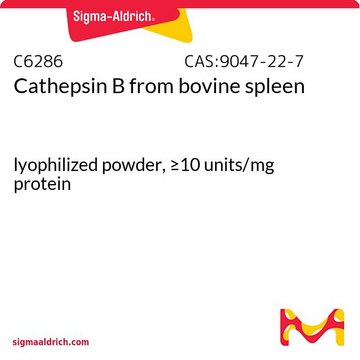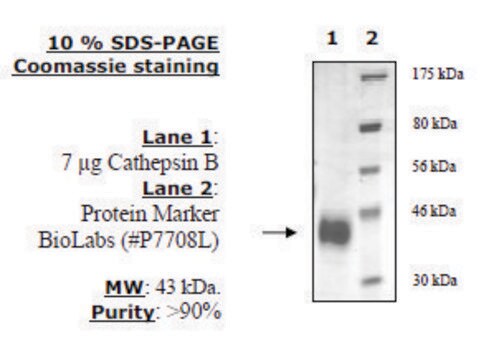SRP0291
Cathepsin L Active human
recombinant, expressed in FreeStyle™ 293-F cells, ≥90% (SDS-PAGE)
Sinónimos:
CATL, Major excreted protein (MEP)
About This Item
Productos recomendados
origen biológico
human
recombinante
expressed in FreeStyle™ 293-F cells
Análisis
≥90% (SDS-PAGE)
formulario
aqueous solution
actividad específica
≥3900 pmol/min-μg
mol peso
36 kDa
técnicas
inhibition assay: suitable
idoneidad
suitable for molecular biology
Nº de acceso NCBI
aplicaciones
life science and biopharma
Condiciones de envío
dry ice
temp. de almacenamiento
−70°C
Información sobre el gen
human ... CTSL(1514)
Descripción general
Cathepsin L is a papain-like cysteine protease and belongs to the Clan A, Family C1. It is composed of L domain of α-helix and an R domain of β-sheet in the spatial structure.
Human cathepsin L (GenBank Accession No. NM_001912), amino acids 18-333, with C-terminal HIS tag, MW = 36 kDa, expressed in FreeStyle 293-F cells.
Aplicación
- to determine that N-acyl and N-sulfonyloxazolidine-2,4-diones are pseudo-irreversible inhibitors of serine proteases
- to investigate the role of cathepsin B and L activity in the serum during the human aging process.
- in inhibitory activity assay
- to study the role of CTSL in COVID-19 infection
Acciones bioquímicas o fisiológicas
Definición de unidad
Forma física
Nota de preparación
Información legal
Código de clase de almacenamiento
10 - Combustible liquids
Clase de riesgo para el agua (WGK)
WGK 1
Punto de inflamabilidad (°F)
Not applicable
Punto de inflamabilidad (°C)
Not applicable
Certificados de análisis (COA)
Busque Certificados de análisis (COA) introduciendo el número de lote del producto. Los números de lote se encuentran en la etiqueta del producto después de las palabras «Lot» o «Batch»
¿Ya tiene este producto?
Encuentre la documentación para los productos que ha comprado recientemente en la Biblioteca de documentos.
Nuestro equipo de científicos tiene experiencia en todas las áreas de investigación: Ciencias de la vida, Ciencia de los materiales, Síntesis química, Cromatografía, Analítica y muchas otras.
Póngase en contacto con el Servicio técnico








